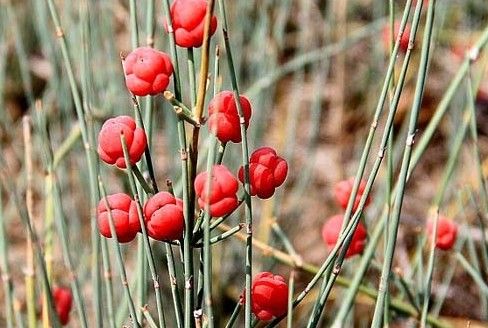Medicinally Ma Huang refers to the herbaceous stems of Ephedra sinica Stapf, Ephedra intermedia Schrenk ex C.A.Mey, or Ephedra equisetina Bge., which is a plant in the family Ephedraceae. It is mainly produced in Xinjiang, Hebei, Shanxi, Inner Mongolia, Gansu and other places. It is usually collected during autumn. After the harvesting, it needs to remove the woody stems, residual root and impurities, and then cut into sections. It is usually used raw, stir-fried with honey, or smashed.
Ephedra plant is a perennial herb, 30 to 50 cm in height. Needle leaves, usually about 1 to 2 millimeters thick, grow upward directly. The color of leaf is always changing according to the seasonal variation – green in summer, yellow in autumn, withered and yellow in winter, and tender green mixed with pale yellow in the following spring. Ephedra fruit turns red and sweet when ripe. Since it is edible and with high nutritional value, people love to pick and eat it when the fruit season comes. But eating too much of it may lead to dizziness. After the fruits are rife enough to fall into the soil or sand, it will sprout and grow in the coming year.
EPHEDRA HEALTH BENEFITS
Ephedrine and pseudoephedrine are the main active ingredient in many anti-tussive, anti-cold and intranasal compound preparations. Unlike its traditional use in China, this herb is extensively used for the purposes of weight loss, bodybuilding, and libido boost. Common brands include Stimerex with ephedra, Xenadrine with ephedra, Metabolife with ephedra, Lipodrene with ephedra, and so on. Besides of ephedra pills, you can also buy ephedra products such as ephedra tea, extract, supplements, etc. It is used as diet pills because it can induce perspiration, promote diuresis, and improve basal metabolic rate; it is used as stamina and sex enhancer because it can increase myocardial contractility, enhance cardiac output, and stimulate central nervous system. In addition, it is considered that the reason why it can help lose weight is based on its effect of suppressing appetite, which results in reduced calorie intake and thus burn off the fat for the energy needed.

Ephedra
HERBAL REMEDIES ON EPHEDRA
The Chinese Pharmacopoeia says that it is acrid and slightly bitter in flavor and warm in nature. It covers meridians of lung and bladder. Prime functions are inducing perspiration to dispel cold, freeing lung to relieve asthma, and inducing diuresis for removing Edema. Essential indications include Common Cold due to wind-cold, chest tightness, cough, and wind-water puffy swelling. Besides, the ephedra stir-fried with honey is able to moisten lung to arrest cough, which is mainly used for Asthma or cough after the exterior syndrome has been cured. Recommended dosage is from 2 to 9 grams.
1. Ma Huang Tang from Shang Han Lun (On Cold Damage). It is combined with Gui Zhi (Cinnamon Twig), Xing Ren (Apricot Seed), and Gan Cao (Licorice Root) to cure wind-cold exterior excess accompanied with wheezing and cough.
2. San Ao Tang from Tai Ping Hui Min He Ji Ju Fang (Formulas of the Peaceful Benevolent Dispensary). It is matched with apricot and licorice to treat excess type dyspnea due to attack of exopathogenic wind-cold and obstructive lung qi.
3. Xiao Qing Long Tang from On Cold Damage. It is formulated with Xi Xin (Herba Asari), Gan Jiang (Dried Ginger Root), Ban Xia (Pinellia), etc. to get rid of cold phlegm, fluid retention, cough, asthma, and clear, thin mucus in the nose.
4. Ma Xing Gan Shi Tang from (On Cold Damage). It is joined with Shi Gao (Gypsum), apricot, and licorice for the treatment of excessive lung heat, high fever, and tachypnea.

![Diseases, Symptoms, tcm, [tcmwindow.com]](/uploadFile/adImg/2015/11/11/f5cbfcc0-4df5-4646-9b9a-f316651a0199.jpg)





